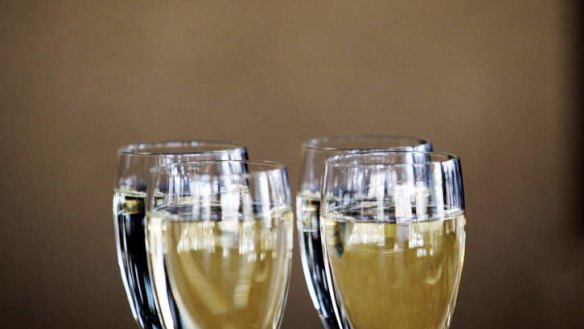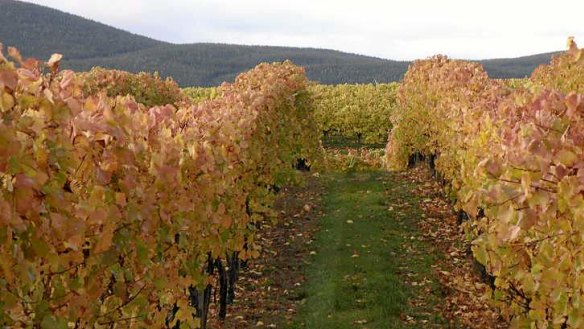NSW's sparkling secret
The sparkling wine from Tumbarumba has been compared to France's great champagnes. Inga Ting uncovers the secret to making a great glass of sparkling.

At just 30 years of age the vineyards in Tumbarumba in southern NSW are babies compared to rival vineyards in Tasmania and Champagne. But this cool climate region is rapidly gaining a reputation for producing top-notch sparkling wines.
The two bubblies featured in the NSW Wine Awards Top 40 – the 2001 Courabyra 805 pinot noir chardonnay pinot meunier and the 2008 Hungerford Hill Dalliance chardonnay pinot noir – were both made with grapes from Tumbarumba. Courabyra's 805 has also won gold at the Australian Wine Show and Cowra Wine Show, while Hungerford Hill's Dalliance picked up bronze medals at the Winewise Small Vigneron Awards (2011), Riverina Wine Show (2011), Cowra Wine Show (2010), Maryville Sparkling Wine Festival (2010) and NSW Wine Awards (2010).
Good Food wine writer, reviewer and wine show judge Huon Hooke says Tumbarumba sparkling wines are among Australia's finest and would be “in good company” beside France's great champagnes.

“I think the best Australian sparkling wine certainly bears comparison with the great champagnes. Also, I think the best wines from Tumbarumba are equal to the best in Australia at the moment, such as Tasmania,” he said.
Three winning components set Courabyra's 805 apart in the most recent NSW Wine awards, Hooke says. Firstly, great fruit from Tumbarumba; secondly, the expert hand of Hardy's Ed Carr, who has extensive experience with Tasmanian grapes; and finally, age.
“Great sparkling wine and great champagne is always wine that's got appropriate ageing on it, but the base wine has to be of good enough quality to justify keeping it on the lees that long – and you only get that from cold places like Tumbarumba, like Champagne, like Tasmania,” Hooke says.
“The very best cool climate grapes … not only justify it, they demand it to make a great glass of sparkling.”
Nestled in the foothills of the Snowy Mountains, Tumbarumba's first vines were planted in 1981 after research showed the region was likely to produce high quality chardonnay, sauvignon blanc and pinot noir grapes.
A high altitude, cool climate region (the average daily maximum temperature is a little above 18 degrees), Tumbarumba's climate is similar to that of Burgundy and Champagne in France.
“We've got a very diverse region. We range from 200 metres above sea level to 800 metres above sea level, so we have a lot of different microclimates and different things that people are good at,” says Cathy Gairn of Courabyra, which is the region's oldest vineyard.
“But along with that comes high risk. A lot of vineyards this year have had bad hail or frost ... that's the risk you get for growing at high altitudes and high rainfall.”
Adding to winemaker woes is the high Australian dollar, says Hungerford Hill owner James Kirby.
“The sparkling market is very tough at the moment because French champagne has come down from $80 a bottle. Now there's lots being sold for $40-50 a bottle, so that's put a lot of pressure on Australian sparkling,” he says.
“We're not seeing the growth that we'd like, but we're holding our own in a very tough market.”
If the tastes of Australian wine drinkers are any indication, however, Tumbarumba sparkling is doing more than hold its own. Wine critic and author of the Good Wine Guide Nick Stock says part of the reason Tumbarumba and other Australian wine regions are gaining more attention is that Australian wine drinkers are developing a greater sense of origin and terroir.
“Australian consumers are moving on from being interested in simple grape variety into a sense of origin and understanding that the same grapes grown in different places will produce wines with different characteristics,” he says.
“Just as we want to know where things on our plate have come from, we also want to know where things in our glass come from … It's a really positive thing. It's a bit of a growing up moment for Australian wine.”
And perhaps for Tumbarumba, too. The fact that the region is still so young bodes well for Tumbarumba winemakers, Stock says.
“It makes it a very exciting prospect to think that in its infancy it's already attracting praise and recognition,” he says. “I think there's a very exciting future for the Tumbarumba region.”
Nor is it a coincidence that Tumbarumba's ascendancy has come at a time when consumers are showing an increasing interest in drinking more elegantly structured, refreshing wines.
“We're drenched in sunshine in Australia and increasingly we're looking to regions with a climatic profile that moderates the nature of our continent,” he says.
“Certain wine styles from cool climate regions are very much in vogue at the moment so it's a natural fit for [Tumbarumba] to be in the limelight.”
Find out more about Tumbarumba and other NSW wine regions at the NSW Wine Festival (February 22 to March 31). Sydney Cellar Door runs from February 22-24, Hyde Park South. The NSW Wine Festival is a Fairfax event.